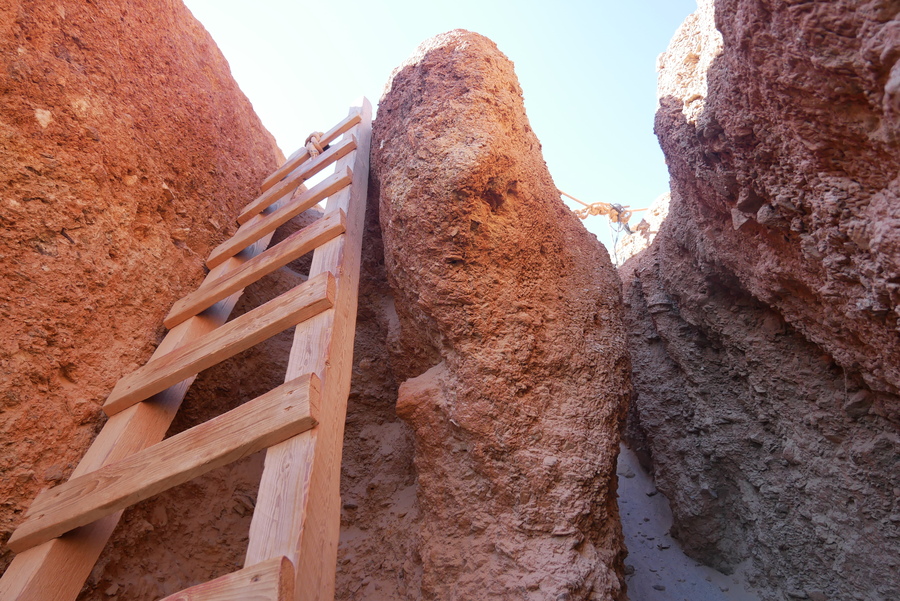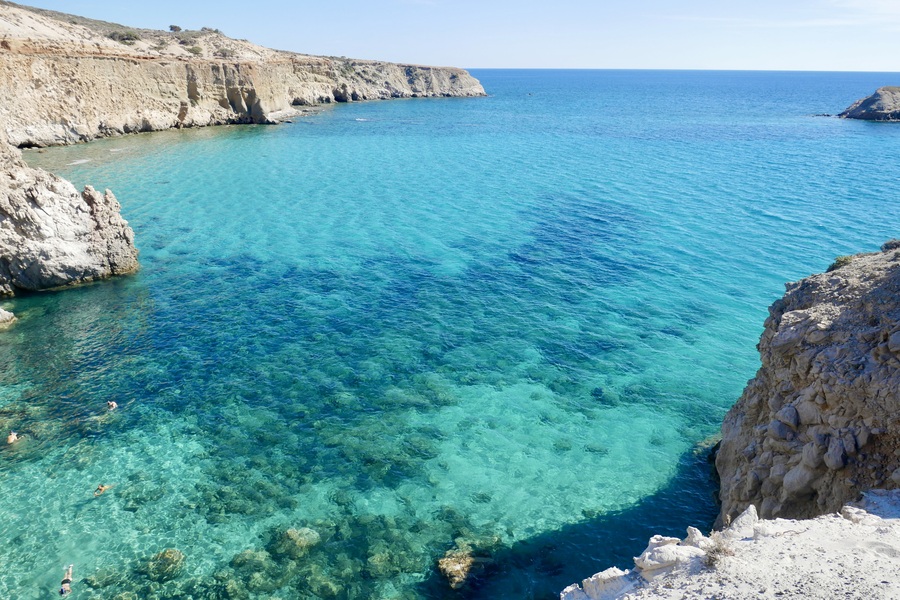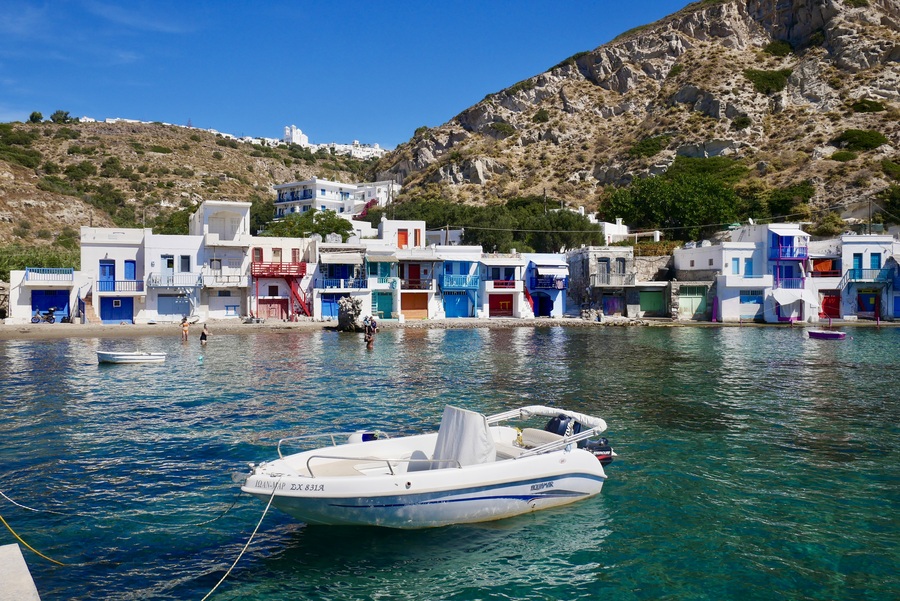
Things to Do in Milos, Greece
Milos is an Aegean gem that features dramatic coastal landscapes and quintessential Cycladic architecture. The Greek island is home to picture-perfect fishing villages, ancient ruins, and remote sun-kissed beaches.
Yet despite its appeal, Milos still manages to fly under the radar. Outside of major tourist attractions like Sarakiniko and Kleftiko, the island is a treasure trove of secluded beaches, isolated swimming holes, and lonely dirt roads.
Milos’ claim to fame, the venerated Venus de Milo, may have found a new home in the Louvre, but the island’s breathtaking scenery and colorful villages provide more than enough reason to visit.
MILOS GREECE: AN OVERVIEW
The island of Milos is one of the most beautiful in Greece. It is among the westernmost islands in the Cyclades, positioned 2.5 hours south of Athens and 2 hours west of Santorini by high speed ferry.
The volcanic island arches around a central caldera. Its eastern half—the part that lies firmly on the tourist trail—is awash with quaint fishing villages and sun-drenched shores. It is easy to navigate and ripe with things to see and do.
The western half of Milos offers an entirely different kind of travel experience. It is remote, desolate, and largely inaccessible.
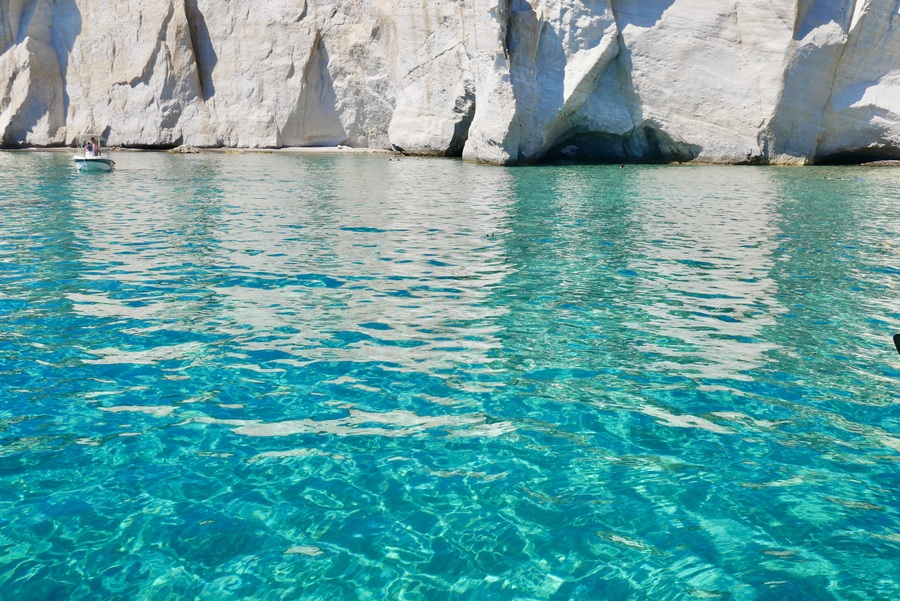
If you like exploring the road less traveled, don’t skip out on western Milos.
We found that the rewards of traveling to the lesser-known corners of the island are absolutely worth the extra effort.
THINGS TO DO IN MILOS
We visited Milos as part of an island-hopping vacation in the Greek Cyclades. Each of the Greek Islands we visited during our trip stood out in one way or another: Santorini for its dramatic caldera views, Naxos for its lush interior, and Paros for its perfect whitewashed towns.
Milos stood out for the sheer variety of its tourist attractions. There are tons of things to do in Milos—from lounging on beaches to photographing villages and from swimming in sculpted sea caves to exploring abandoned mines.
SARAKINIKO LUNAR LANDSCAPE
Sarakiniko is undeniably Milos’ #1 attraction. Instagrammers have discovered the area’s lunar topography and the crowds have followed suit. The landscape around Sarakiniko is a photographer’s dream. Its otherworldly meringue-like rock formations are compelling to explore and photograph.
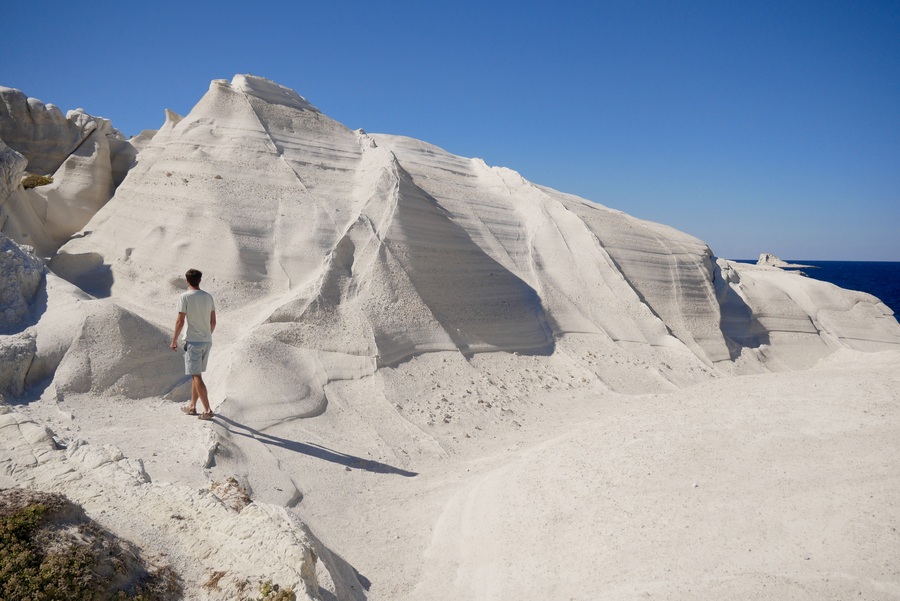
The beach itself at Sarakiniko is quite small and pales in comparison to some of Milos’ other unspoiled stretches of sand.
But the beach isn’t the main reason that thousands descend on Sarakiniko’s bizarre and otherworldly terrain.
To best appreciate the uniqueness of the chalk-white landscape, I recommend wandering to the left of the beach and climbing over the ridges of white rock. The grippy rock is quite easy to climb, as it provides fantastic traction.
Though it is different in nearly every way, I couldn’t help but be reminded of the White Desert in Egypt.
KLEFTIKO SEA CAVES
Kleftiko is located along the southern coast of Milos. Alongside Sarakiniko, it is a top Milos attraction.
The shoreline at Kleftiko showcases sheer, sandy-colored cliffs that drop precipitously into the shimmering Aegean Sea. Tunnels and caves dot the landscape and provide ample opportunities for exploration.
It is said that pirates once hid out in Kleftiko’s coves, but today you’ll find mostly catamarans and snorkeling visitors.
The water near Kleftiko is incredibly clear. I’ve been to few other places in the world that can claim such a dizzying patchwork of turquoise and blue. Orak Island in Bodrum Turkey is probably my closest comparison.
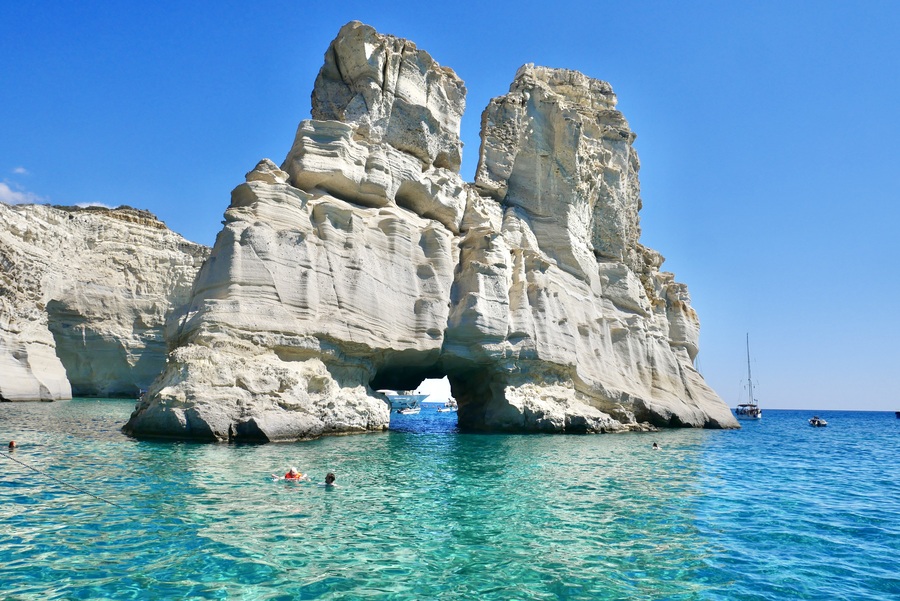
The Kleftiko rock formations are difficult to access independently, so almost everyone visiting the area comes as part of a boat tour.
We traveled to Kleftiko with Delfinia Tours. It was the cheapest option we could find and was the only half-day excursion that allowed us to bring Elio. Since we were traveling with a nine month old baby, we felt that embarking on a full-day snorkel tour would be overkill.
The excursion was great, but had we not been traveling with a baby, we would have likely sprung for a full day boat tour of Milos that included the island’s western coast as well.
PAPAFRAGAS CAVES AND BEACH
Carved into the cliffsides along Milos’ northern coast, the Papafragas Caves resemble a large rectangular swimming pool. The caves consist of three channels that cut through the chiseled cliffs—forming hidden coves and sea arches. The area is one of the more unique swimming destinations in Milos.
Small beaches lie at the end of two of the small channels. To reach the small strips of sand, visitors can take a path that leads to the base of the cliffs.
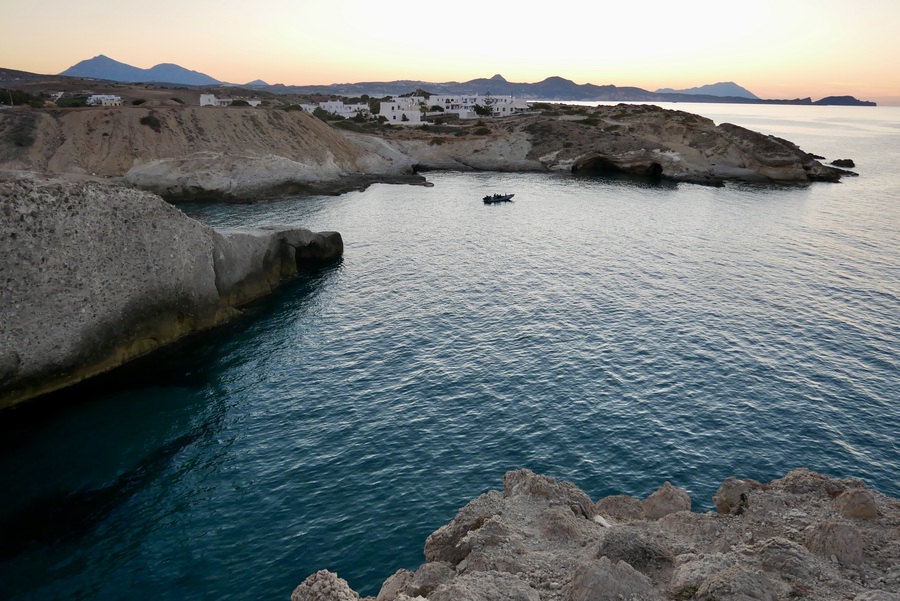
We didn’t head down to the beach, since we stopped by Papafragos as the sun was setting.
However, we took a moment to walk along the narrow pathway and admire the coastal scenery from above.
MILOS BEACHES
Of all the Cycladic islands we visited during our island-hopping adventure, Milos stood out for the quality and quantity of its beaches. In fact, I wouldn’t be surprised if Milos has some of the best beaches in Greece.
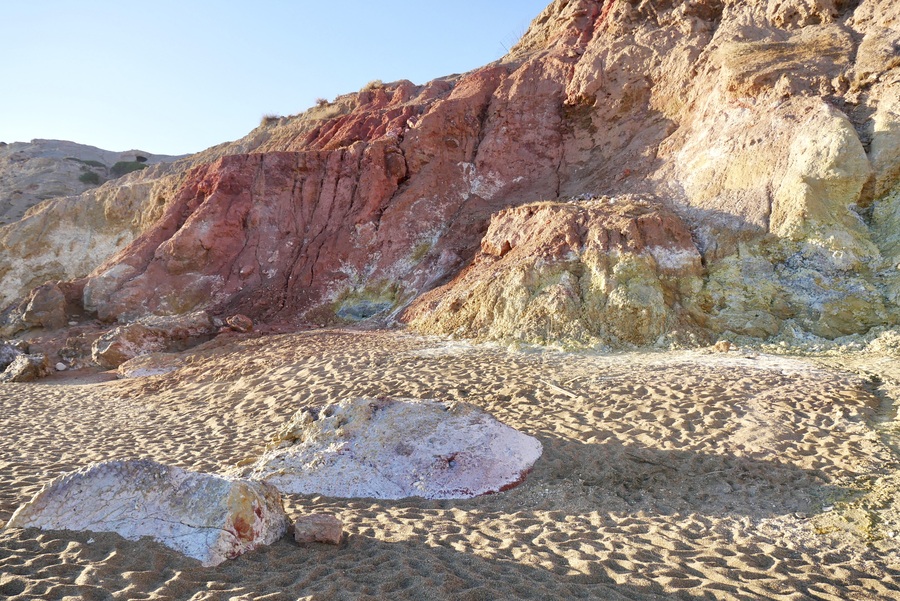
Milos has more than 75 strips of sand that line its spectacular shoreline. The beaches in Milos range from crowded and family-friendly to secluded and off-the-beaten-path.
-
TSIGRADO BEACH
Tsigrado Beach is among the most iconic attractions in Milos. The water around Tsigrado Beach shimmers under the Aegean sun. Its colors range from pale turquoise to deep cobalt blue. They encompass every color in between.
Reaching Tsigrado Beach requires scrambling down a ladder that lies sandwiched between a crevice in the cliffs. While it is not a particularly treacherous climb, be sure to use caution. Accessing the sand can be challenging and somewhat dangerous.
Dan and I didn’t feel comfortable bringing Elio down Tsigrado Beach’s ladder, so we left him with my parents during our quick visit to the area.
If you are apprehensive about scrambling down the wooden ladder, know that the views from above are just as worthwhile.
-
FYRIPLAKA BEACH
Fyriplaka is among the most popular beaches in Milos. It boasts a long stretch of golden sand and clear shallow water. While nearby Tsigrado is difficult to reach, Fyriplaka is both kid-friendly and accessible.
The most iconic feature of Fyriplaka Beach is a rocky outcrop that lies about halfway along the bay. It has a natural archway that is possible to swim through.
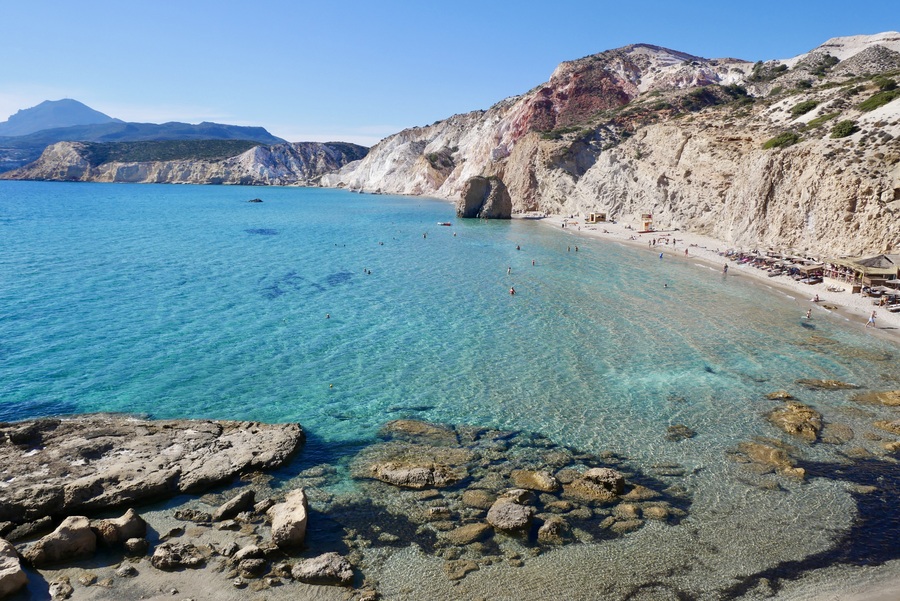
Straw umbrellas line the long stretch of beach at Fyriplaka. They provide the only means of shade, so they tend to fill up quite quickly.
-
PALEOCHORI BEACH
One of the island’s most beautiful beaches, Paleochori forms a long crescent of golden sand and rocks. It is backed by banded cliffs that vary in color from yellow to red to white to black. The beach is full of tourist amenities.
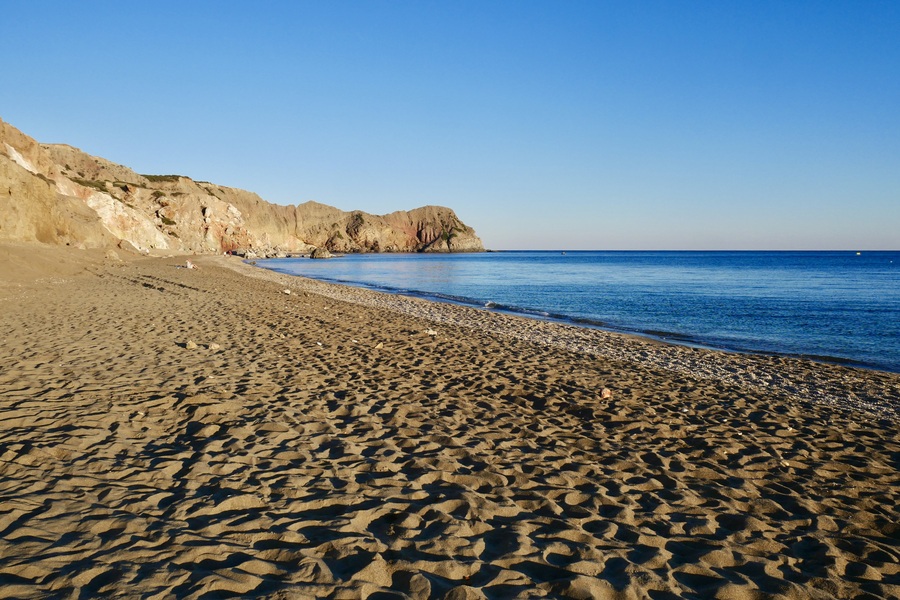
Paleochori Beach is a full-service destination with restaurants and activity rentals. Sirocco Restaurant is a popular place to eat. The restaurant offers dishes cooked in the sand using thermal heat, thanks to an underground spring that warms the area’s sand.
COLORFUL FISHING VILLAGES
Milos is known for its picturesque and colorful fishing villages. Three of the island’s villages in particular—Klima, Firopotamos and Mandrakia—are famous for the brightly painted garage doors. These colorful doors are known as syrmata in Greek. Each whitewashed home is carved directly into the surrounding rocks and comes with its own uniquely painted syrmata.
The two-story design of the syrmata homes is quite practical. The bottom serves as a boat garage, while the second floor makes for a living space.
-
KLIMA
Klima is a fishing port that boasts some of the most colorful syrmata in Greece. It is one of the most photogenic spots on the island and a top Milos itinerary destination.
Once a hub of seafaring activity on the island, the Greek town is now mostly abandoned. A few of the colorful garages contain tourist shops, while others have been converted into unique rentable accommodations. Just a handful of full-time residents live in the syrmata today.
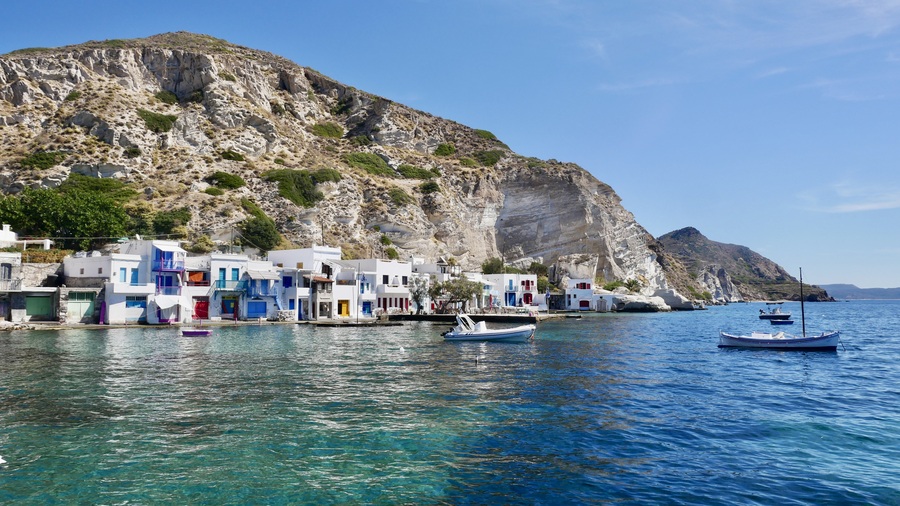
Aside from taking photos and admiring the architecture, there isn’t a ton to do in Klima. The village is small and easy to visit within an hour. It contains a sandy area and a couple of restaurants. Most who come to Klima spend just a short time walking the narrow path between the syrmata and the sea, which brushes right up against the buildings during high tide.
-
FIROPOTAMOS
Firopotamos is one of a handful of idyllic fishing villages located on coastal Milos. The town lines a picturesque bay with crystal clear water.
Colorful syrmata, a quintessential Cycladic church, and a ruined doorway all make the quaint fishing village of Firopotamos a must-see destination.
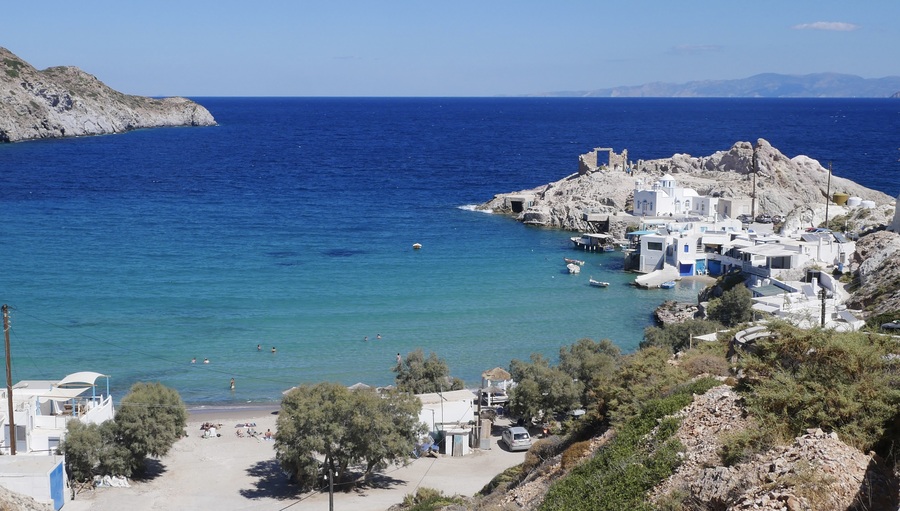
In addition to its photogenic buildings and ruins, Firopotamos boasts one of Milos’ most popular beaches. A few large trees on the beach provide respite from the searing Mediterranean sun.
-
MANDRAKIA
Like Firopotamus, Mandrakia is small and easy to tour in less than an hour. But it still packs a punch when it comes to charm.
Mandrakia boasts photogenic whitewashed homes with colorful doors and one of the top restaurants in Milos (Medusa). Small fishing boats bob up and down, surrounded by the iridescent blue of the Aegean.
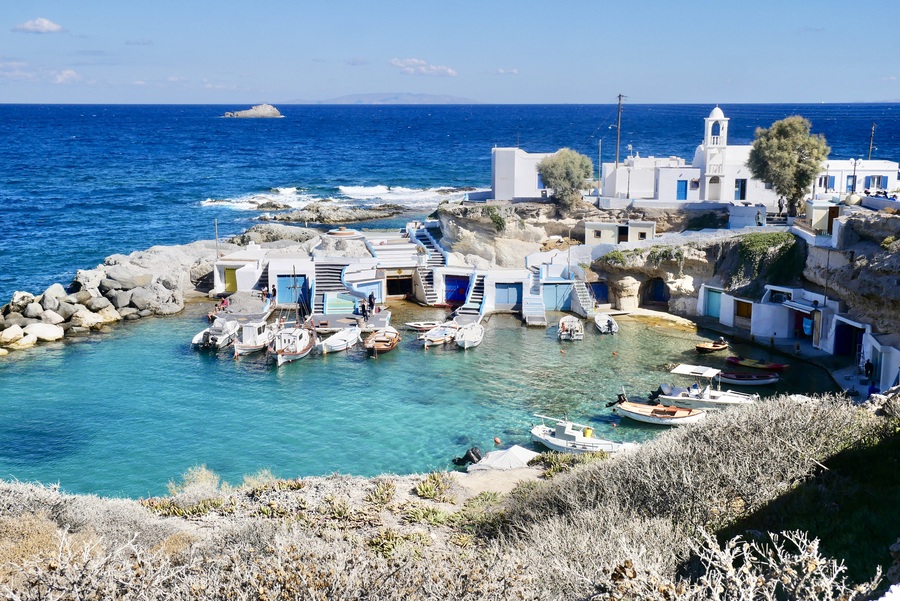
It is worth walking to the right of the church and exploring the backside of Mandrakia. Hidden from prying eyes, the smaller bay to the right of the village is ripe with photo opportunities. Syrmata lie nestled into the rocks, pounded by crashing waves.
In the distance, the lunar landscape of Sarakiniko forms a backdrop.
POLLONIA
Pollonia lies at the northern tip of Milos. It is one of the most popular places to stay during a Milos holiday due to its sandy beach, bayside setting, and traditional tavernas.
A string of wonderful restaurants line the waterfront to the right of Pollonia’s family-friendly public beach. We ate at Gialos and had one of the best meals of our Greek Isles vacation.
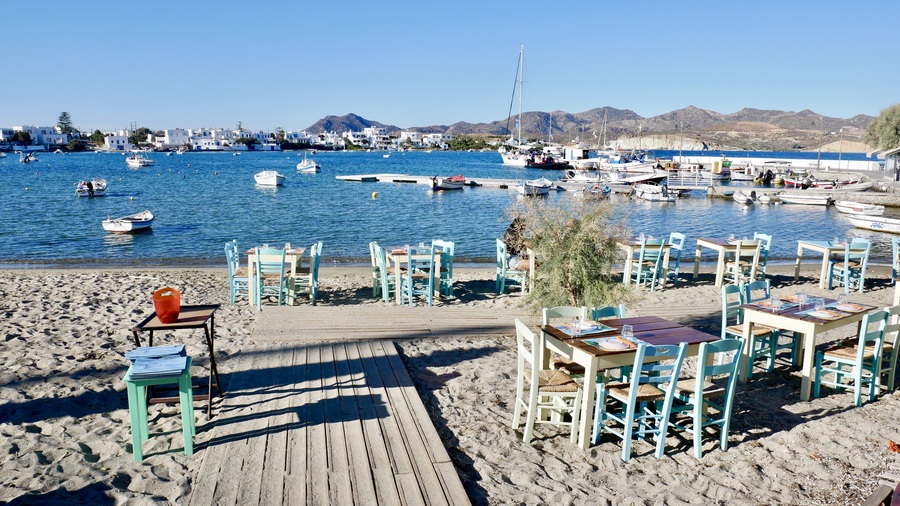
Aside from the beach and eateries, there isn’t a whole lot to do in Pollonia itself. Many travelers use the town as a springboard for trips to the Kimolos and Polyegos islands.
PLAKA AND ITS CASTLE
The hilltop town of Plaka is a gem that lies perched up in the hills, northeast of Adamantas. The town showcases whitewashed Cycladic architecture, narrow cobble-stone streets, and a Venetian castle. A nice selection of restaurants and cafes lie tucked away in the town’s narrow alleyways. Among them is Palaios Bakery, home to the best watermelon pie on the entire island. Dan and I still dream about their ladenia.
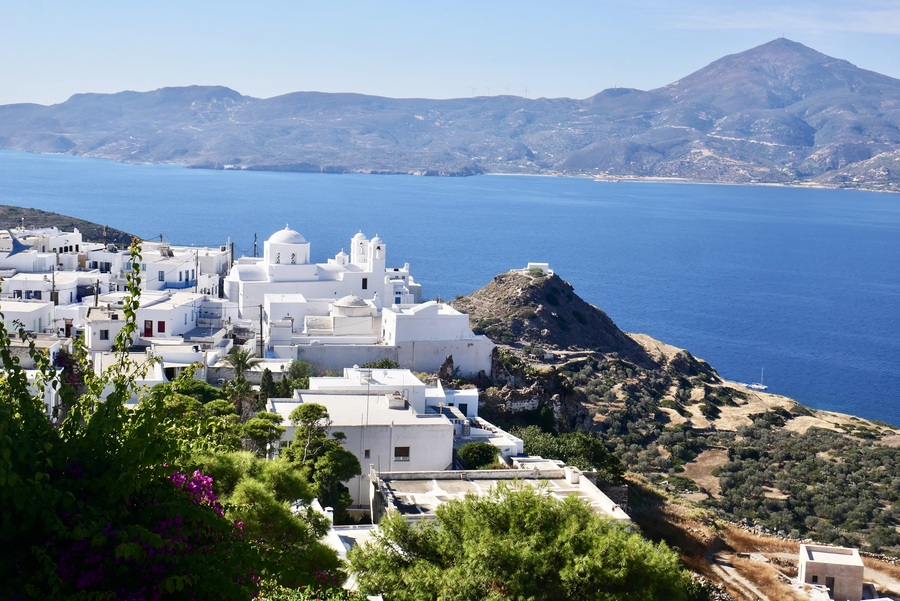
You can access the Plaka Castle by walking up a winding pathway that ascends the hill behind town. The pathway passes by the beautiful churches of Panagia Korfiatissa and Panagia Thalassitra
Soaking in the views from Plaka’s Venetian castle is one of the top things to do in Milos. The castle, built in the 13th century, was crucial in defending the Greek island from pirates due to its lofty position.
Little of the castle remains today, but views from the top extend over most of the island.
TRYPITI MILOS
Trypiti Village is essentially an extension of Plaka. It sits on the lower slopes of the village, near many of Milos’ top archaeological attractions.
Trypiti’s whitewashed architecture includes windmills, churches, and typical Cycladic homes. The Church of Agios Nikolaos—noticeable from far away because of its distinct bell towers—is the town’s main landmark.
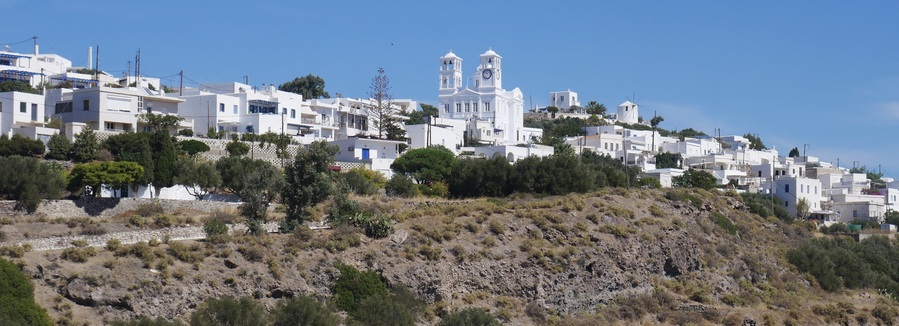
Picturesque Trypiti isn’t always included in Milos itineraries, but the town is worth a quick look around.
ANCIENT MILOS THEATER
Clinging to the hillside below Trypiti and above Klima, Milos’ large Roman-era theatre entertained the island’s citizens from the 1st to the 4th century AD. Only around a tenth of the original structure has been uncovered and partially restored, including part of an intricately carved marble facade that overlooks the piercing blue sea.
To the right of the path, a replica of the armless Parian marble statue—the Venus de Milo—stands on a platform.
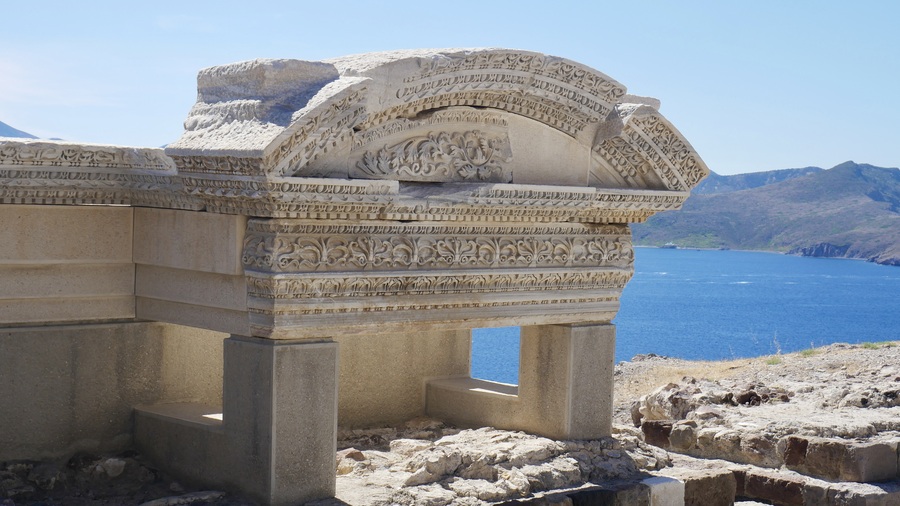
The archaeological site is free to visit and worth strolling around during a trip to Milos. It isn’t exactly the Acropolis, but it does represent some of the best-preserved ruins that we saw during our island-hopping itinerary.
THE MILOS CATACOMBS
Greece’s only Christian catacombs, on the slopes below Trypiti, date from the 1st century. Over 2000 people were interred within the subterranean network of tunnels. The Catacombs of Milos are considered to be the most important early Christian monument in all of Greece. They are among the most important catacombs worldwide.
Visiting the catacombs consists of a 15 minute guided tour that explores two main chambers.
Though the Catacombs of Milos were part of our original itinerary, we ended up not visiting due to lack of time.
THEORYCHIA SULFUR MINES
The Theorychia Sulfur Mines cling to the orangey hills above Paliorema Beach, along the southeastern coast of Milos. Built in 1930, they were used primarily for the extraction of sulfur that was then exported to France for pesticide use.
The Milos Sulphur Mines S.A. employed an efficient method of recovering sulphur from ore. This method was used until 1958, when the company faced bankruptcy following a massive drop in sulphur prices. In many places around the world, sulphur mining was no longer economically feasible. (Pure sulphur is still extracted on a small scale at sites such as Kawah Ijen in Indonesia, although this relies on low labour costs and the absence of expensive machinery.)
When the mining industry in Milos collapsed, workers abandoned the Theorychia Mines, along with their machinery and tools.
Today, old machinery and some rusty tools remain in place as an open-air memorial to the past. Other recovered items from the Theorychia Mines can now be found in the Milos Mining Museum.
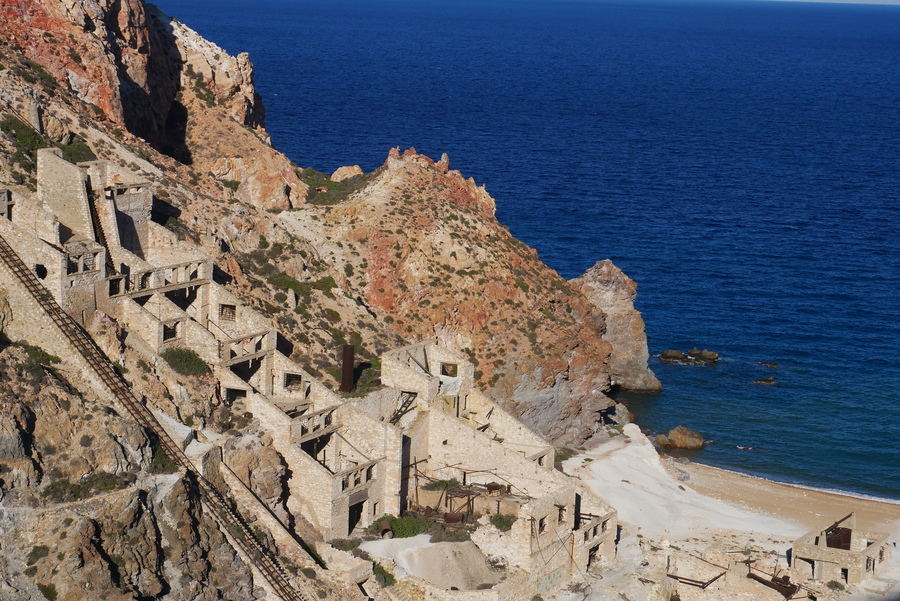
The sulphur mines in Milos require a 4WD vehicle to access, as the dirt road is poorly maintained and full of deep potholes.
If you’re spending more than two days in Milos, a visit to the mines is absolutely worthwhile. It can be easily combined with a dip in the emerald waters of Paliorema Beach nearby.
WHERE TO STAY IN MILOS
We stayed at the Villa Windmill near Zefiria during our trip to Milos. The unique accommodation is less than a 15 minute drive from Adamantas, but it provides a rural retreat complete with chickens, a grassy field, and views of the surrounding pastures.
It is truly a wonderful little oasis and Elio enjoyed every second of our stay.
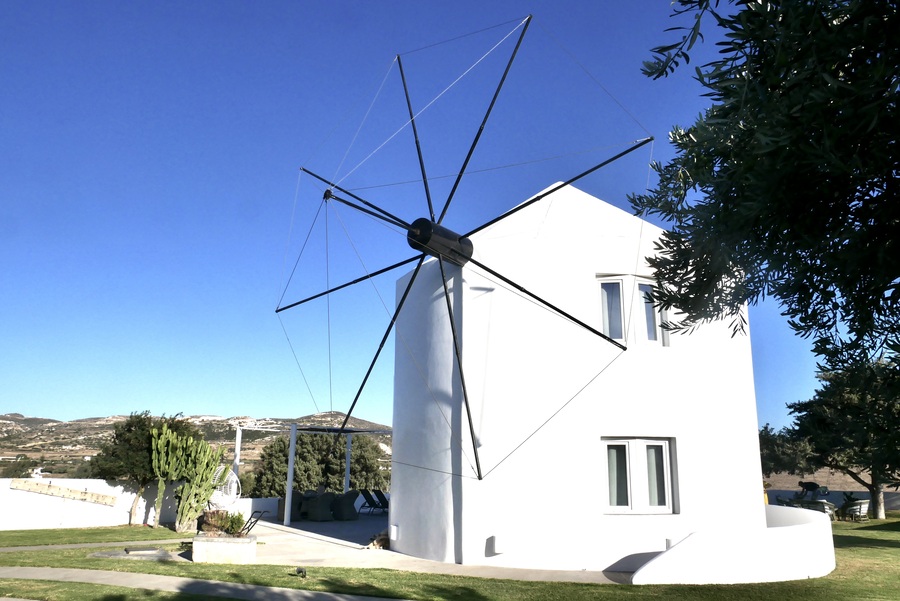
If you’re looking for a more urban setting, you might want to consider staying in Adamantas—the island’s centrally-located transportation hub. On the cheap end, Sarakiniko Rooms offers a clean place to stay just outside the bustle of town. It is well-located and boasts stellar reviews.
If you’re traveling with a large group or don’t mind splurging, you might want to consider renting out the lovely Villa Soleil in Adamantas. The 3 bedroom house has a beautiful terrace, a hot tub, and spacious rooms.
WHEN TO VISIT MILOS
During June through August, hot sunny and summer holidays bring throngs of visitors to Milos. While I imagine that peak season crowds are more manageable than in Santorini or Mykonos, I still recommend visiting during the shoulder season.
May and September are the best months to travel in Milos. During these off-peak times of year, visitors can enjoy beautiful weather, quieter beaches, and cheaper accommodations.
My family and I visited the Greek Isles in late September. The weather was perfect, crowds were manageable, and we found it easy to book rental cars and accommodations without prior reservations.
GETTING AROUND MILOS
To best enjoy Milos’ diverse offerings, I recommend renting a car. There really isn’t a way of getting to all of the island’s top attractions using public transportation.
A substantial chunk of western Milos is technically off-limits to rental vehicles due to bad roads. We asked our rental company about travel to the western half of the island, however, and got the go-ahead. We just had to pay a little bit extra in insurance costs.
There are some parts of Milos that remain completely off-limits to vehicles. Much of the island’s dramatic western coastline is best accessed by boat. Sea-based tours of the island are plentiful and easy to book online or on the spot in Adamantas.
ISLAND HOPPING FROM MILOS
Milos connects with the rest of Greece by boat. Frequent ferry connections link the island with other destinations in the Cyclades—including Santorini, Ios, Paros, and Naxos. You can find details and timetables at Ferryhopper.com
We took a ferry to Milos from Paros and had no difficulty booking last minute. Following our lovely stay in Milos, we took a last-minute ferry to Athens.
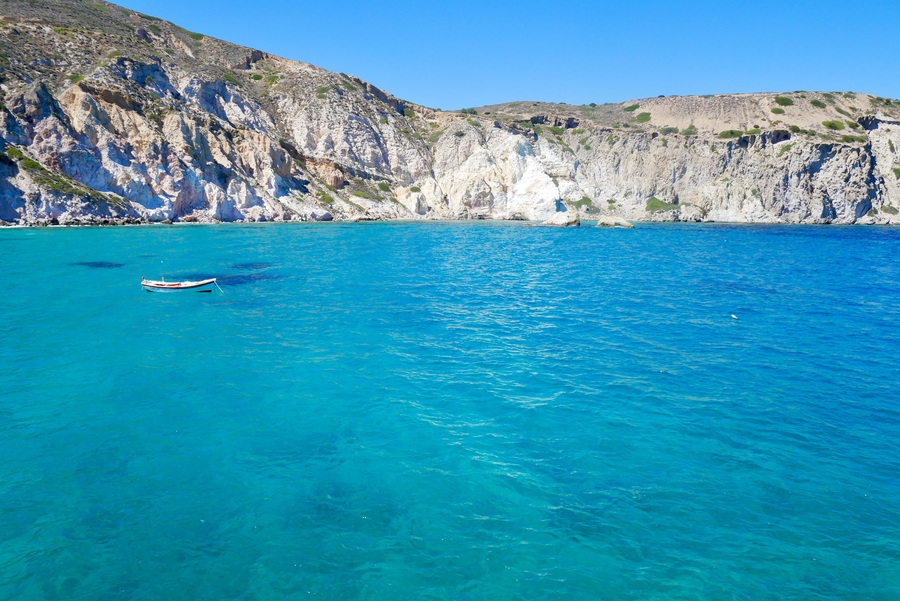
If you’re looking to fly, you’ll be able to find tickets between Milos and Athens on Olympic Air and Sky Express.
****
Places like Sarakiniko and Kleftiko might have put Milos on the map, but they represent only a tiny fraction of the island’s offerings.
If you take the time to explore both Milos’ well-trodden and off-the-beaten path destinations, you’ll discover an island that has a little bit of something for everyone: photogenic towns, idyllic beaches, lovely pastoral landscapes, and ancient history.
In terms of tourism offerings, Milos is a travel destination that punches far above its size. The island may be small, but its attractions are as varied as they are plentiful.



